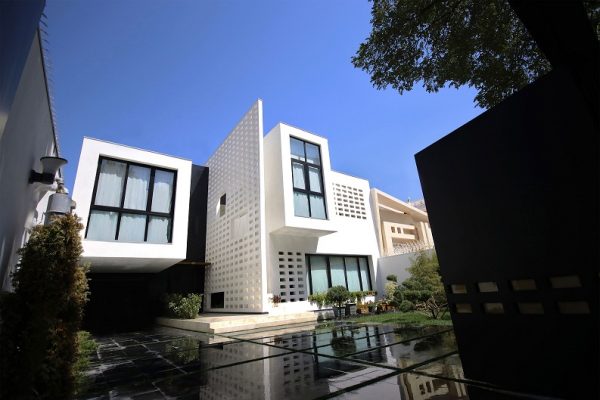نوع مقاله : مقالۀ پژوهشی
نویسندگان
- سارا غلامی 1
- جمال الدین سهیلی 2
- کمال رهبری منش 3
1 پژوهشگر دکتری، گروه معماری، دانشکده معماری و شهرسازی، واحد قزوین، دانشگاه آزاد اسلامی، قزوین، ایران.
2 دانشیار، گروه معماری، دانشکده معماری و شهرسازی، واحد قزوین، دانشگاه آزاد اسلامی، قزوین، ایران.
3 استادیار، گروه معماری، دانشکده معماری و شهرسازی، واحد قزوین، دانشگاه آزاد اسلامی، قزوین، ایران.

باغ نظر (ماهنامه)
دوره 18، شماره 103
دی 1400
صفحه 64-49
بیان مسئله: عرصههای اجتماعی و فرهنگی ایران شاهد تحولات وسیعی در دوران پهلوی دوم بوده است. یکی از مهمترین مؤلفههای تأثیرگذار در شکلگیری این تحولات، ورود مدرنیسم در نظام فکری جامعه و شکلگیری طبقه متوسط جدید در آن دوره است؛ بالطبع گونههای مسکن ظهور یافته این طبقه اجتماعی نیز در این دوره دستخوش تغییرات اساسی شد. نوشتار حاضر بر آن است تا ضمن الگوبرداری از مسکن طبقه متوسط جدید پهلوی دوم، الگوهایی نوین جهت مسکن طبقه متوسط معاصر پیشنهاد نماید.
هدف پژوهش: این پژوهش در صدد است با استفاده از دستور زبان شکل، که بر پایه به کارگیری معناشناسانه زبان شکل است، به قوانین حاکم بر کالبد گونههای مسکن طبقه متوسط جدید جامعه در دوره پهلوی دوم دست یابد و از این طریق، الگوهای طراحی متنوعی در مسکن اقشار متوسط امروز جامعه خلق نماید. در این راستا، کوی نارمک از دوره میانی و شهرک اکباتان از دوره پایانی پهلوی دوم به عنوان جامعه نمونه انتخاب و با توجه به شاخصهای اجتماعی- فرهنگی مسکن مورد ارزیابی قرار گرفت.
روش پژوهش: اساس روش این تحقیق کیفی، تاریخی- تفسیری است؛ در ابتدای این تحقیق، طی یک بررسی تاریخنگارانه به تأثیر طبقات اجتماعی بر ساختار خانهها پرداخته شده است و سپس با روش توصیفی- تحلیلی، ابعاد کالبدی- فضایی خانهها مورد بحث قرار گرفته است. روش تحلیل دادهها در این پژوهش، دستور زبان شکل است. اطلاعات مورد نیاز در این پژوهش از طریق مشاهده و بررسیهای میدانی، مطالعات کتابخانهای و اسنادی جمعآوری گردیده است.
نتیجهگیری: براساس نتایج تحقیق، اجزاء خانههای این دوره تحت تأثیر تفکرات و معماری مدرن غرب بودهاند و در مقایسه با مسکن سنتی تهران دستخوش تحولات اساسی شدهاند. ریزفضاهای مسکن به حداقل کاهش یافته و از یک دستور زبان شکلی پایه پیروی میکنند: چگونگی قرارگیری فضاها در این خانهها براساس جانمایی یک عنصر پایه است. شکل پایه، فضاهای درهم (عرصههای نشیمن و ناهارخوری) در نظر گرفته شد و سپس سایر فضاها براساس مجموعهای از قوانین، به شکل پایه اضافه شد. در انتها براساس فرایند الگوریتمی دستور زبان شکل، با بهرهگیری از درخت تصمیمگیری، به خلق الگوهای متنوعی برای طراحی مسکن امروزی انجامید.
عنوان مقاله [English]
Middle-Class Housing Analysis in the Second Pahlavi Period Based on the Shape Grammar (Case Study: Narmak Neighborhood and Ekbatan Town of Tehran)
نویسندگان [English]
- Sara Gholami 1
- jamaleddin soheili 2
- kamal rahbarimanesh 3
Problem statement: The social and cultural areas of Iran have undergone extensive changes during the second Pahlavi era. One of the most important influential indicators in these developments is modernism in the intellectual society system. The formation of a new middle-class in the second Pahlavi period is a sign of modernism achievements. Even the housing types of this social class also reflect their fundamental changes during this period. The present article intends to model the new middle-class housing of the second Pahlavi and suggests new models for contemporary middle-class housing.
Research objective: This research seeks to achieve new middle-class housing rules in the second Pahlavi period by using grammar and develop a variety of design patterns in the housing of today’s middle classes. In this regard, Narmak neighborhood from the middle period and Ekbatan town from the last period of the second Pahlavi were selected as a sample community and were evaluated according to the socio-cultural indicators of housing.
Research method: The basis of this qualitative research method is interpretive history; at the beginning of this article, during a historiographical study, the effect of social classes on the structure of houses has been studied, and then the physical-spatial dimensions of houses have been discussed by the descriptive-analytical method. The method of data analysis in this research is shape grammar. The information required in this research has been collected through field observations, library studies, and documentation.
Conclusion: According to the results of the research, the components of the houses of this period have been influenced by modern Western ideas and architecture and have undergone fundamental changes in comparison with the traditional housing of Tehran. The micro-spaces of the dwellings are reduced to a minimum and follow a basic shape grammar: arrangement of spaces in these houses is based on the location of a basic element. The basic shape was considered to be multipurpose spaces (living and dining areas) and then other spaces were added to the basic shape based on a set of rules. Finally, based on the algorithmic process of shape grammar led to the creation of various patterns for the modern housing design.
تحلیل مسکن طبقۀ متوسط دورۀ پهلوی دوم براساس دستور زبان شکل (مطالعۀ موردی محله نارمک و شهرک اکباتان تهران) اصل مقاله 2.56 MB
صاحب امتیاز: پژوهشکده هنر، معماری و شهرسازی نظر
مدیر مسئول: دکتر سید امیر منصوری
سردبیر: دکتر احمد پوراحمد
دوره انتشار: ماهنامه
شاپا چاپی: 1735-9635
شاپا الکترونیکی: 2251-7197




















